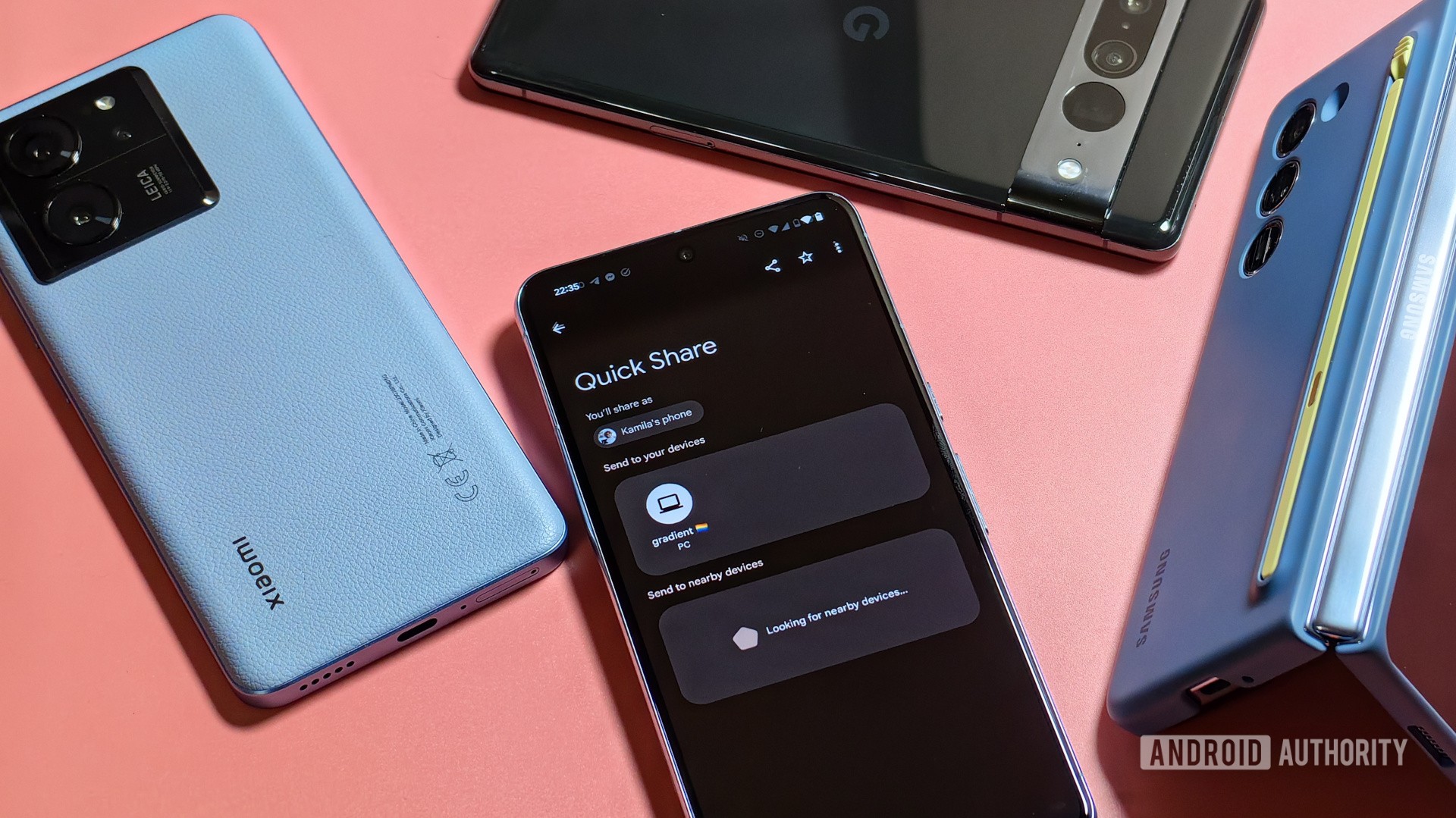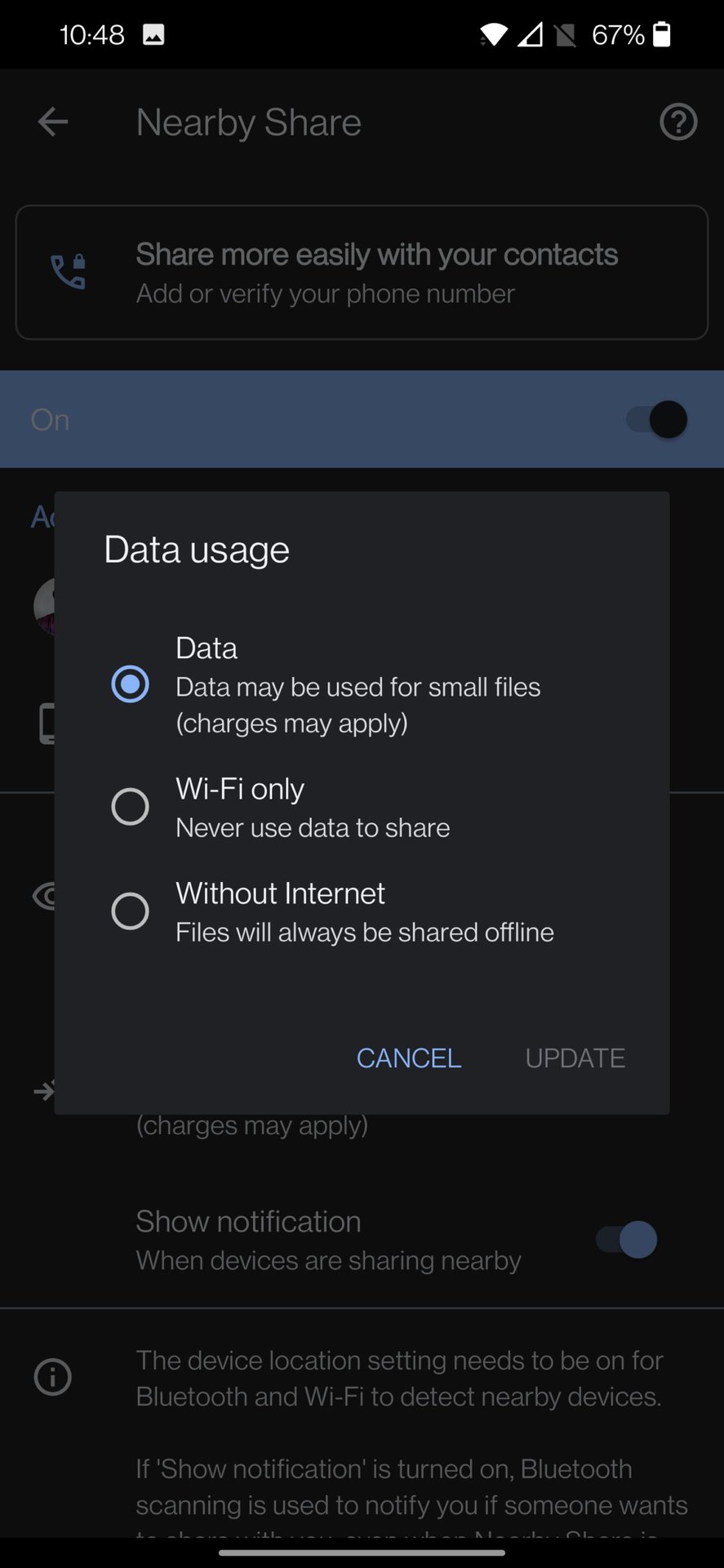Affiliate links on Android Authority may earn us a commission. Learn more.
What is Nearby Share and how to get started with it
Published onJanuary 18, 2024
It can be a pain to share large files between Android phones. Most email and messaging apps have attachment size limits or will completely ruin the quality of images and videos because of file compression. The preferred alternative is to upload the file to a cloud storage service and share a link, but those have storage limits and other inconveniences. Google has a solution, though. Originally known as Nearby Share but now referred to as Quick Share, the feature lets you easily share images, videos, files, links, and Wi-Fi passwords between Android, Chromebooks, and Windows devices. Here’s everything you need to know about Quick Share and Nearby Share and how to use it.
QUICK ANSWER
Nearby Share, recently rebranded to Quick Share, is a feature that lets you quickly and easily share images, videos, documents, links, and more between two Android devices, a phone and a Chromebook, or a phone and a Windows PC. It's available on all smartphones running Android 6.0 or higher, but phones with more recent Android versions have more features.
JUMP TO KEY SECTIONS
What is Nearby Share?

Nearby Share is Google’s answer to Apple AirDrop, albeit a decade late. It works similarly to AirDrop and lets you transfer files between Android devices at the tap of a button once you have the feature set up. The beta version of Nearby Share was available on select Pixel and Samsung smartphones in June 2020 before releasing to every Android phone running Android 6.0 and higher in August of that year.
Samsung’s version of the feature received the title Quick Share. It’s largely consistent with Nearby Share but differs slightly regarding file transfer limits and simultaneous sharing.
In the near future, both Google and Samsung will use the Quick Share moniker to refer to the feature. As Google confirmed at CES 2024, the new version is set to roll out in February 2024 to phones that currently support Nearby Share.
While AirDrop relies on offline transfers, you can use cellular data and Wi-Fi (peer-to-peer) with Nearby Share and Quick Share, along with Bluetooth, Bluetooth LE, and WebRTC for online and offline sharing. Newer versions of Android also bring new features with them. You can share your Wi-Fi password from a phone running Android 12 (the receiving phone can run an older Android version).
Nearby Share officially rolled out to Windows devices in July 2023, allowing Android users to share files or entire folders with their laptops seamlessly. There are now talks between Google, Samsung, and PC makers like LG to bring Quick Share functionality to their Windows devices.
The feature’s naming scheme is confusing, and its functionality is imperfect. People come across different issues when using Nearby Share that we’ll get into later.
How to enable Nearby Share
Nearby Share isn’t active by default, so you must first enable the feature. Go to Settings > Google > Devices and sharing > Nearby Share and toggle the button.
We expect that enabling Quick Share will involve similar steps, but we’ll be sure to update this guide once the new version rolls out to devices.
Frequent users might want to add a shortcut to their phone’s Quick Settings menu if it isn’t there already. Swipe down to open the Quick Settings menu and tap on the pen icon next to Settings. Look for Nearby Share on the list of additional toggles and drag and drop it into the shortcuts.
How to send a file using Nearby Share
Find the document, image, photo, or link you want to send to someone else and tap on the Share icon. Depending on the type of file and its location, you might have to long-press or tap on the three vertical dots icon at the top right corner.
In this example, I’m sharing a video file from Google Photos. Long-press the file, tap on the share icon at the top, and tap on More in the Share to apps section. You should see an icon at the top that says Nearby if you have enabled the feature. Look for Nearby Share on the list of apps if you don’t see the button.
The phone will look for the other Android phone. Tap on its name when it pops up in the menu. Your phone will generate a four-digit PIN code that the other person can use to verify that you are sending the file.
How to receive a file using Nearby Share
If the file transfer request is sent correctly, you will see a pop-up asking you to verify the PIN code and accept the transfer. Tap on Accept. The file will transfer to the other device.
How to find a file I received using Nearby Share
If it’s an image or video, you will see it in the Download folder in Google Photos or the phone’s media app. Documents and other file types will be in the phone’s Download folder. Open your file manager app and go to Downloads to find it.
Website and social media links will automatically open using the necessary app. The other phone should automatically connect to the network if you use Nearby Share to share your Wi-Fi password.
Nearby Share settings and features
The two necessary settings to know about are Device visibility and Data. Device visibility lets you select who can send you a file transfer request.
- Contacts: You can choose to be visible to all contacts or select specific people on the list. This is the best option if you know the person and they are already on your contact list.
- Everyone: Choose this if you don’t have the person on your contact list. The feature works if the two phones are close to each other, so you don’t have to worry about receiving random requests. But you can set Everyone mode to temporary. The app will reset to your default settings after a few minutes.
- Hidden: Hidden will hide your device and stop anyone from sharing files with you until you change your visibility settings.

You should also change the Data setting, so you don’t run into unnecessary cellular data charges.
- Data: Data lets you use mobile data to transfer files. Ensure that you use this option only if it’s a small file, webpage, or social media link to avoid additional charges.
- Wi-Fi only: This mode will only use Wi-Fi to transfer files between two phones. It’s easier if both phones are on the same Wi-Fi network. Otherwise, it will set up a Wi-Fi Direct connection.
- Without internet: This mode will use offline methods to transfer the file. It’s slower, so it isn’t ideal for large files.
Finally, if you enable the Show notification setting, the phone will use Bluetooth to let you know when someone is trying to send a file to you, even if Nearby Share isn’t active.
What to do if Nearby Share isn’t working
There are a few problems users come across when using Nearby Share.
- Can’t find the other phone: If you’re having trouble locating the phone to which you want to transfer a file, it could be because of the other phone’s device visibility settings. Check and ensure you’ve changed the option to Contacts or Everyone. Remember that the temporary Everyone mode turns off automatically after a few minutes.
- Transfer speeds are too slow: You will want to use Wi-Fi or cellular data (if you have a robust data plan) for the fastest transfer speeds. Bluetooth and WebRTC are comparatively much slower and aren’t ideal for large files.
- Devices not connecting: If you’ve checked the settings and are still not able to connect to another device, try toggling the feature off and on, enabling and disabling Airplane Mode, or restarting the device. Also, check that Bluetooth, Wi-Fi, and location services are enabled on both phones. Ensure that the devices are close to each other. Nearby Share works within a 1ft radius.
- Clear the app cache: The feature is available on your device through Google Play Services. Try clearing the app cache if nothing else works. Check out our guide on how to clear the cache on Android.
- Not working on Windows: Your configuration might be the issue. Nearby Share for Windows requires a 64-bit installation. It also doesn’t work on ARM-based Windows devices.
FAQs
From February 2024, Nearby Share will rebrand to Quick Share. Quick Share was originally Samsung’s version of Google’s Nearby Share, but the rebranded version will likely amalgamate the two experiences.
Yes, Nearby Share allows safe transfers between two Android devices. Even if you have your device visibility set to Everyone, you will have to accept a transfer request before someone can send a file to you.
You can quickly and easily share files between Android devices and a Chromebook. Nearby Share on Android isn’t available on Windows or Macs.
No, Nearby Share will not let you transfer files between an Android device and an iPhone.
Go to Settings > Google > Devices and sharing > Nearby share and tap on the toggle to disable the feature.